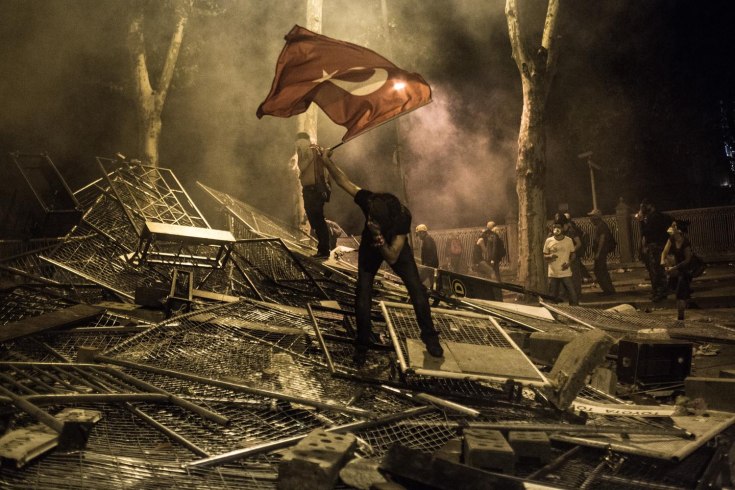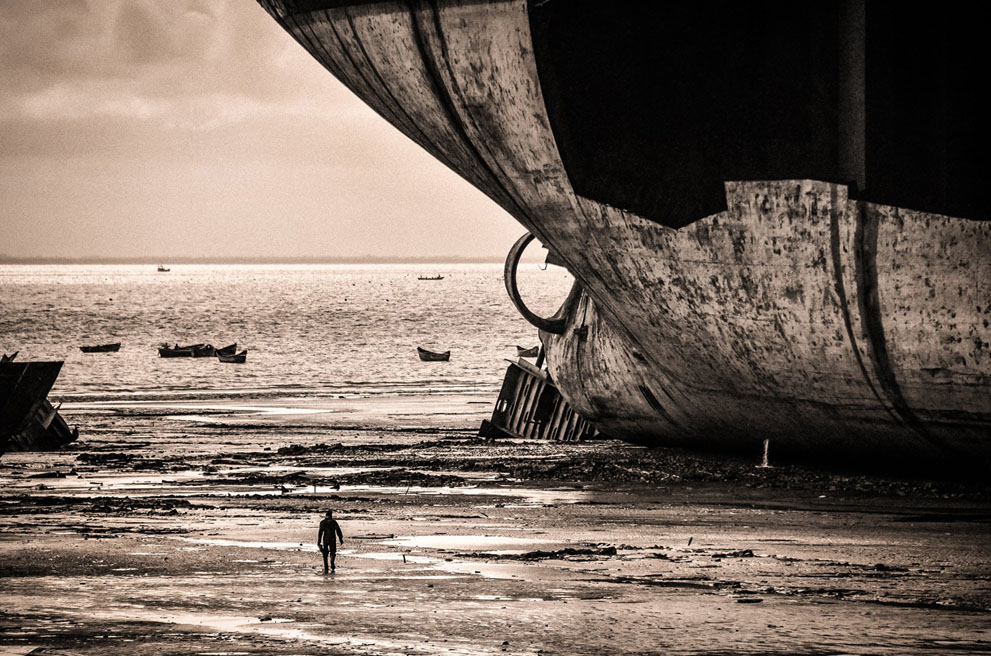You might say that this image is all too conventional: the people’s hero bravely taking a stand on the barricades, right out of Les Miz. Of course, it’s much better than that, but why?
All the elements of the Revolution in the Streets script are there: the people milling about (check); smoke from tear gas or guns (check); trashed furniture and other stuff piled up as a barricade (check); the hero at the center of the barricade (check); the standard held high precisely as the hero is being sacrificed (check); what’s not to like? Well, someone might say, “He’s a real human being actually putting his body on the line.” OK, but we knew that, and the drama never was entirely in the image: politics itself is a mode of conflict before spectators, and if you take away all the conventions of presentation, the scene becomes aimless, meaningless, incapable of being seen as action of any sort. Like any photograph, this image has to draw on conventions of social behavior to be intelligible at all, and like many photographs it might be artfully compressing and coordinating those conventions to say something to a public audience.
But what is being said? We can’t settle for something as banal as “Protestor waves a flag in Istanbul,” or even the more dramatic “Protestor waves a flag in Istanbul while being gassed.” Let me suggest that two reasons I think this photo stands out above many others. The first is the way that the man is framed, not by other protestors or the police, but by the wreckage being created by the conflict in the street. Instead of merely becoming a symbol of The People, we see that he actually is having to contend with the destruction of his environment. (Indeed, the willingness to accept that destruction is one sign of how fed up people are with the deeper destructiveness of the regime.) While holding up the flag and covering his contaminated eyes, he also has to step carefully, each foot on a different level, obstacles that could trip him in every direction. More to the point, the photo may be prophetic: suggesting that, as with other revolutions in the region, this one will end in the Pyrrhic victory of regaining one’s country only to find it gutted, looted, and reduced to rubble.
One need not come to that conclusion, of course, but the second distinctive feature of the photograph provides a context for doing so: now I am referring to its amazing color. It’s much easier to see than describe, so look again. Neither quite color nor black and white, it seems to create a dimension halfway between documentary reportage and artistic reflection. Color can provide tone (in oratory, the speaker’s sense of the situation), and mood (the emotion offered to the audience as a means for thinking and feeling along with the speaker). The tone here seems both candid about the dire situation and yet willing to believe in the cause. The mood seems almost elegiac, as if they have already lost but should be remembered nonetheless.
To appreciate more fully what has been accomplished, let me briefly bring in another photo.
Amazing, isn’t it? One might think that all these two images have in common is their similarity in color, tonality, and mood. Or one might feature important differences: say, that the second places human action within an expansive natural tableau where serenity will persist long after these small creatures called humans have passed through the scene. Either way, the comparison could be faulted for trivializing the political action in Istanbul. That, however, is not what I have in mind.
Consider instead that the second image can extend some of the strengths of the second. It can slow us down a bit to think more carefully about the nature of change. Note also that both images feature wreckage (the looming hulk is a supertanker being cut up for scrap in Bangladesh). Perhaps wreckage is our lot, and therefore no reason to avoid change. And perhaps regimes, no matter how large and powerful, will all one day be cut up for scrap. (They will, as they always have.)
Perhaps the scripts don’t change much, but that need not determine how we feel about them.
Photographs by Daniel Etter/Redux and Lee Chong Kuang/National Geographic Traveler Photo Contest. Etter’s photo was included in a guest post earlier this week on viral images in Turkey; Time Lightbox provides more on the photo here.
Cross-posted at BagNewsNotes.


[…] Photographic Mood, on the Eve of Destruction (No Caption Needed) […]